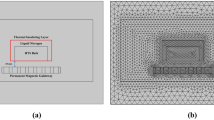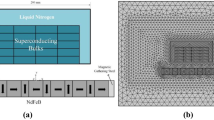Abstract
In the actual operation of the high temperature superconducting (HTSC) maglev, due to the irregularity of the permanent magnetic guideway (PMG), the superconducting bulk always fluctuates in a small range. In order to explore this influence on the levitation force and guidance force, this paper considers that the superconducting bulk drops from the field cooling height (FCH) to the working height (WH), then maintains for a while and returns to the FCH, during the whole process of which the PMG has been subjected to the stochastic lateral and vertical excitations. Two E-J’s constitutive relations are used in COMSOL Multiphysics 5.6, and compared with the model without excitations. The results show that for the levitation force, the lateral excitation mainly affects its amplitude, while the vertical excitation mainly affects its overall trend and position of the peak value. The more intense the excitation’s fluctuation, the weaker the effect of the magnetic flux flow. For the guidance force, the lateral excitation mainly affects its amplitude and fluctuation’s intensity, while the vertical excitation’s influence is so small that can be neglected. When the superconducting bulk moves near the peak value, the effect of magnetic flux flow is particularly obvious, while near the equilibrium position, the effect is weak. On the whole, the magnetic flux flow has a distinct impact on the vertical excitation than on the lateral excitation. When without excitations, the magnetic flux flow is relatively obvious. These results reveal the rules providing the reference for the design of the HTSC maglev.













Similar content being viewed by others
References
Brandt, E.H.: Levitation in physics. Science 243, 349–355 (1989)
Ki, T., Jeong, S., Han, Y.H., et al.: Thermal packaging of high temperature superconductor bulk for superconducting flywheel energy storage. IEEE Trans. Appl. Supercond. 25(3), 5701104 (2013)
Nakamura, T., Tamada, D., Yanagi, Y., et al.: Development of a superconducting bulk magnet for NMR and MRI. J. Magn. Reson. 259, 68–75 (2015)
Werfel, F. N., et al.: “Superconductor bearings, flywheels and transportation,” Supercond. Sci. Technol., vol. 25, 2012, Art. no. 014007
Hull, J.R.: Superconducting bearings. Supercond. Sci. Technol. 13, R1–R15 (2000)
Murakami, M.: Processing and applications of bulk RE–Ba–Cu–O superconductors. Int. J. Appl. Ceram. Technol. 4, 225–241 (2007)
Okano, M., Iwamoto, T., Furuse, M., Fuchino, S., Ishii, I.: Running performance of a pinning-type superconducting magnetic levitation guide. J. Phys. Conf. Ser. 43, 999–1002 (2006)
Deng, Z., Li, J., Zhang, W., Gou, Y., Ren, Y., Zheng, J.: High temperature superconducting magnetic levitation vehicles: dynamic characteristics while running on a ring test line. IEEE Veh. Technol. Mag. 12(3), 95–102 (2017)
Wang, J.S., et al.: The first man-loading high temperature superconducting maglev test vehicle in the world. Physica C 378–381, 809–814 (2002)
Stephan, R.M., de Andrade, R., Ferreira, A.C.: Superconducting light rail vehicle: a transportation solution for highly populated cities. IEEE Veh. Technol. Mag. 7(4), 122–127 (2012)
Schultz, L., deHaas, O., Verges, P., Beyer, C., Rohlig, S., Olsen, H., Kuhn, L., Berger, D., Noteboom, U., Funk, U.: Superconductively levitated transport system−the SupraTrans project. IEEE Trans. Appl. Supercond. 15, 2301–2305 (2005)
Deng, Z., et al.: A high-temperature superconducting maglev–evacuated tube transport (HTS maglev–ETT) test system. IEEE Trans. Appl. Supercond. 27(6), 3602008 (2017)
Deng, Z., et al.: A high-temperature superconducting maglev ring test line developed in Chengdu. China. IEEE Trans. Appl. Supercond. 26, 3602408 (2016)
Huang, H., et al.: Effect laws of different factors on levitation characteristics of high-Tc superconducting maglev system with numerical solutions. J. Supercond. Novel Magn. 32, 2351–2358 (2019)
Chen, L., et al.: Numerical simulations on the vertical dynamic characteristics of high-temperature superconducting bulk. Journal of Superconductivity and Novel Magnetism (2021) 06 January
Ma, et al.: Levitation height drifts of HTS bulks under a long-term external disturbance. J. Supercond. Novel Magn. 32, 3803–3810 (2019)
Qin, et al.: 3D-modeling numerical solution of guidance force of HTSC bulk above permanent magnetic guideway. J Supercond Nov Magn 24, 1357–1361 (2011)
Alloui, et al.: Numerical study of the relation between the thermal effect and the stability of the levitation system excited by an external source. Physica C 487, 1–10 (2013)
Guo, X.F., et al.: Drift of levitated/suspended body in high-Tc superconducting levitation systems under vibration-part 1: a criterion based on magnetic force-gap relation for gap varying with time. IEEE Trans. Appl. Supercond. 17(3), 3795–3802 (2007)
Guo, X.F., et al.: Drift of levitated/suspended body in high-Tc superconducting levitation systems under vibration-part 2: drift velocity for gap varying with time. IEEE Trans. Appl. Supercond. 17(3), 3803–3808 (2007)
DIAS DHN et al.: Emulation of full-scale maglev vehicle behavior under operational conditions. IEEE Trans. Appl. Supercond. 23(3), 360054 (2013)
Zheng, J., et al.: A general method to simulate the electromagnetic characteristics of HTS maglev systems by finite element software. IEEE Trans. Appl. Supercond. 28(5), 3600808 (2018)
Author information
Authors and Affiliations
Corresponding author
Additional information
Publisher's Note
Springer Nature remains neutral with regard to jurisdictional claims in published maps and institutional affiliations.
Rights and permissions
About this article
Cite this article
Yang, J., Chi, M., Wu, X. et al. A Simulation on Levitation Force and Guidance Force of the HTSC Bulk Under the Permanent Magnetic Guideway’s Stochastic Excitation. J Supercond Nov Magn 34, 3099–3114 (2021). https://doi.org/10.1007/s10948-021-05969-w
Received:
Accepted:
Published:
Issue Date:
DOI: https://doi.org/10.1007/s10948-021-05969-w




